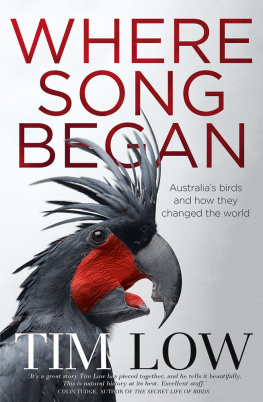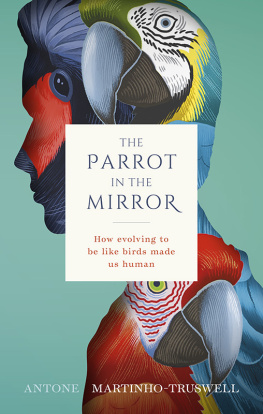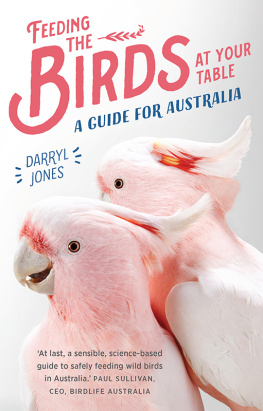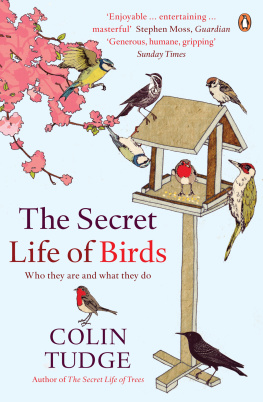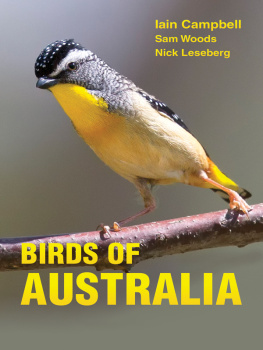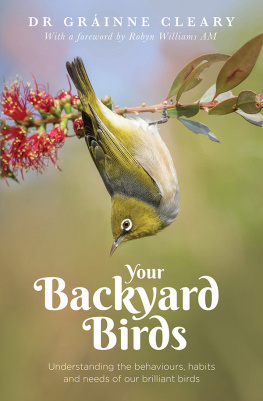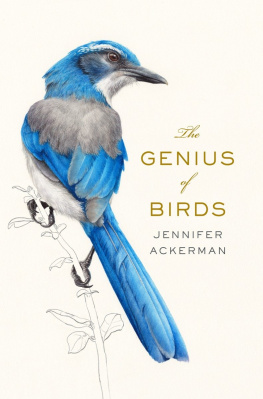Because the information in this book was accumulated over more than two decades I cannot hope to acknowledge everyone who helped with information or company in the field. In the text I mention many biologists and naturalists who showed me birds or provided interviews or information for which I am very grateful. I wont repeat their names here, with the exception of Les Christidis and Richard Schodde, who each submitted to several hours of questioning, and Sara Legge, John Woinarski and Stephen Garnett, who responded patiently to many questions about grassland birds. I am not implying that any experts I consulted agree with my conclusions.
The Australian Antarctic Division awarded me an Antarctic Arts Fellowship to visit Antarctica and Macquarie Island, and I thank Rob Easther and Cathy Bruce in particular. In 2012 I benefited from a Churchill Fellowship to investigate climate change biology in the Northern Hemisphere, since birds were part of the focus. Roger Kitching, Griffith University, invited me to Sabah. The Hawaii Conservation Alliance was generous with accommodation in Honolulu.
Carol Booth helped in every way possible from pointing out birds in the field to locating journal articles and editing several chapters. Doug Laing provided accommodation and excellent company in Zimbabwe and elsewhere and found me passage on a barge serving Torres Strait. Jayne Balmer and Cascade Cohousing provided accommodation and generous hospitality during multiple visits to Hobart. Simon and Rose Cavendish loaned their car for a Kimberley trip. Jenny Horwood proofread the text with great care. Terry Reis helped in many ways. Others I am grateful to include Steve Anyon-Smith, Patrick Couper, Neil Doran, Nic Dunlop, Owen Foley, Mark Holdsworth, Conrad Hoskin, Gerald Mayr, Geoff Monteith, Tony Nicholas, Damon Oliver, Lisa Preston, Mark Read, Robbie Ward.
People outside Australia who helped include Malcolm Ausden (UK), Maryanne Bache (US, Mexico), Jack Craw (New Zealand), Peter Gaze (New Zealand), Jack Jeffrey (Hawaii), Linda Kelly (Zimbabwe, US), Wilberforce Okeka (Kenya), Sonja Wipf and Christian Rixen (Switzerland). To those I have forgotten to mention I apologise. To minimise the carbon footprint most of my overseas travel was undertaken following invited attendance at conferences and workshops.
For the support that Penguin provided I am very grateful. My editor, Meredith Rose, showed a level of commitment that I suspect is rare in publishing these days, and which shines through in every aspect of this project and led to many improvements. Ben Ball as publisher was also very committed to producing the best possible book. Alex Ross provided an excellent cover and Adam Laszczuk a wonderful text design.
Bibliography
Abbott CL and Double MC (2003) Genetic structure, conservation genetics and evidence of speciation by range expansion in shy and white-capped albatrosses, Molecular Ecology 12: 295362.
Aggerbeck MJ, Fjelds J, Christidis L, et al. (2014) Resolving deep lineage divergences in core corvoid passerine birds supports a proto-Papuan island origin, Molecular Phylogenetics and Evolution 70: 27285.
Anderson T (1849) On a new species of manna from New South Wales, Edinburgh New Philosophical Journal 47: 1329.
Angas GF (1847) Savage Life and Scenes in Australia and New Zealand. Smith, Elder, London.
Archer M, Hand S and Godthelp H (1996) Riversleigh, Reed, Melbourne.
Banfield EJ (1908) Confessions of a Beachcomber, T. Fisher, Unwin, London.
Barbour RC, Crawford AC, Henson M, et al. (2008) The risk of pollen-mediated gene flow from exotic Corymbia plantations into native Corymbia populations in Australia, Forest Ecology and Management 256: 119.
Barker FK, Barrowclough GF and Groth JG (2002) A phylogenetic hypothesis for passerine birds: Taxonomic and biogeographic implications of an analysis of nuclear DNA sequence data, Proceedings of the Royal Society B 269: 295308.
Barker FK, Cibois A, Schikler P, et al. (2004) Phylogeny and diversification of the largest avian radiation, Proceedings of the National Academy of Sciences of the United States of America 101: 1104045.
Basden R (1966) The composition, occurrence and origin of lerp, the sugary secretion of Eurymela distincta (Signoret), Proceedings of the Linnean Society of New South Wales 91: 44.
Beadle NCW, Evans OD, Carolin RC, et al. (1982) Flora of the Sydney Region, Reed, Frenchs Forest, NSW.
Beehler BM, Pratt TK and Zimmerman DA (1986) Birds of New Guinea, Princeton University Press, Princeton, New Jersey.
Bell HL (1982) A bird community of lowland rainforest in New Guinea. 1. Composition and density of the avifauna, Emu 82: 2441.
Bell Miner Associated Dieback Working Group (2004) Bell miner Associated Dieback (BMAD) Strategy, Department of Environment and Conservation (NSW), Coffs Harbour.
Bennett G (1860) Gatherings of a Naturalist in Australasia, Van Voorst, London.
Bird MI, Hutley LB, Lawes MJ, et al. (2013) Humans, megafauna and environmental change in tropical Australia, Journal of Quaternary Science 28: 43952.
Boland C (2000) Shy albatross, Nature Australia 26: 22.
Boles WE (1995) Preliminary analysis of the Passeriformes from Riversleigh, northwestern Queensland, Australia, with the description of a new species of lyrebird, Courier Forschungsinstitut Senckenberg 181: 16370.
(1999) A new songbird (Aves: Passeriformes: Oriolidae) from the Miocene of Riversleigh, northwestern Queensland, Australia, Alcheringa 23: 5156.
(2005) Fossil honeyeaters (Meliphagidae) from the Late Tertiary of Riversleigh, north-western Queensland, Emu 105: 2126.
(2006) The avian fossil record of Australia: An overview. In: Merrick JR, Archer M, Hickey GM, et al. (eds) Evolution and Biogeography of Australasian Vertebrates. Australian Scientific Publishing, Sydney.
Bomford M and Sinclair R (2002) Australian research on bird pests: impact, management and future directions, Emu 102: 2945.
Bond WJ and Midgley JJ (1995) Kill thy neighbor an individualistic argument for the evolution of flammability, Oikos 73: 7985.
Bond WJ, Woodward FI and Midgley GF (2005) The global distribution of ecosystems in a world without fire, New Phytologist 165: 52537.
Bonyhady T (2000) The Colonial Earth, Miegunyah Press, Carlton, Vic.
Bowman D, Brown GK, Braby MF, et al. (2010) Biogeography of the Australian monsoon tropics, Journal of Biogeography 37: 20116.
Bowman DMJS (2000) Australian Rainforests: Islands of Green in a Land of Fire, Cambridge University Press, Cambridge, UK.
Bradstock RA, Williams RJ and Gill AM (2012) Flammable Australia: Fire Regimes, Biodiversity and Ecosystems in a Changing World, CSIRO Publishing, Melbourne.
Brooke MD (2004) The food consumption of the worlds seabirds, Proceedings of the Royal Society B 271: S246S48.
Bryant N (1985) Outdoors; bird smuggling is on the rise. New York Times. New York.
Burbidge NT (1960) The phytogeography of the Australian region,

